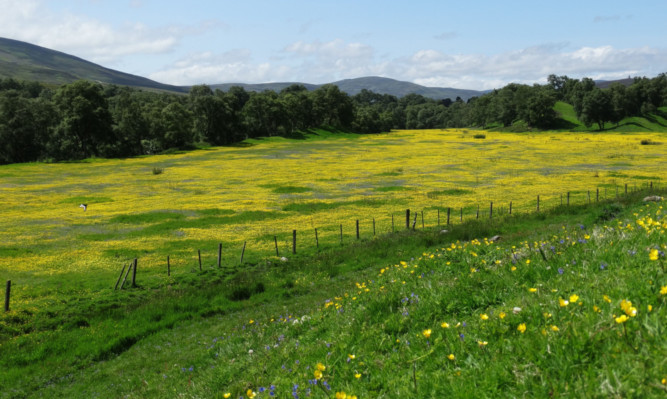Angus Whitson uncovers some natural treasure.
Wednesday morning, you’ll recall, was sunny and warm. Out first thing with the dogs the early sun caught the tiny, white star-shaped flowers of sticky willy. They must be one of the smallest wild flowers you’ll find in the hedgerows.
In the afternoon we took a favourite walk up the bank of the River North Esk from Inveriscandye farm steading, just to check that while we’d been away on holiday there had been nothing going on that we should know about.
The river is low and sluggish and needs a couple of days of good downpour. It’s a poor outlook for fishermen because there’s too little oxygen in the water and the fish become sluggish too and even less inclined to be caught than usual!
Cow parsley is one of the commonest countryside plants and, incidentally, smells of aniseed. Fast growing and tall, it is so rife along the riverbank as to be almost invasive.
The flowers have died off leaving smooth green seed pods packed with seeds which will scatter and germinate and next spring the problem will be worse.
It amuses me how some plants have alternative names quite at odds with each other. Queen Anne’s Lace describes cow parsley’s white froth of lacy flowers, but was the good queen amused when she realised she was associated with a herby ruminant?
July is a good month for wild flowers but there’s a danger they get crowded out by the thick, lush vegetation.
Lesser knapweed, which looks like a tall spineless thistle, outgrows its neighbours. I saw more bumble bees on that walk, feeding on the purple heads, than I’d seen so far this year and last year combined, which was very encouraging. Less so that I didn’t see one honey bee.
There were spikes of pink woundwort, sometimes called heal-all and used in herbal medicine to stop bleeding. Purple tufted vetch is a climbing plant with tendrils at the end of its leaves to help it scramble through the undergrowth to get to the sun and light. Blue cranesbill poking through the grass provided more flashes of colour.
I saw white campion and purple campion. Not as tiny as sticky willy, but a much more delicate plant, stitchwort’s white flowers will show up on the track up the river for the next couple of months.
Pink and white wild roses, or dog roses, are in full bloom. It’s hard to associate my two hideous hounds with such delicate flowers. In autumn the bright red hips will make a cheerful display until winter.
A solitary guelder rose growing in the woods beside the steading has large clusters of white flowers which will turn to red berries in the autumn to match the colour of the autumn leaves. In reality it’s not a rose bush, but a small deciduous shrub normally found in gardens.
More suited to gardens than the countryside is pink spiraea. A small hedge of this ornamental shrub is growing beside the river. It’s a mystery how it established itself there for it doesn’t have berries with pips which can be carried by birds for natural seeding.
Back home the bird feeders are busy. At this time of year the birds don’t miss us while we are on holiday but word gets about pretty quickly when we start feeding again. We have a healthy population of house sparrows and occasional visits from hedge sparrows. There was a time when I didn’t bother to try and tell them apart and every sparrow was just a spuggie.
Siskins and goldfinches are daily visitors and a greenfinch, or maybe there’s more than one, has started putting in an appearance.
On Wednesday evening I drove up Glenesk. In the haugh across the road from The Retreat Folk Museum a blaze of yellow shimmered in the fading sun. I can’t think when I’ve seen a field so completely carpeted in buttercups just like a field of cloth of gold.
